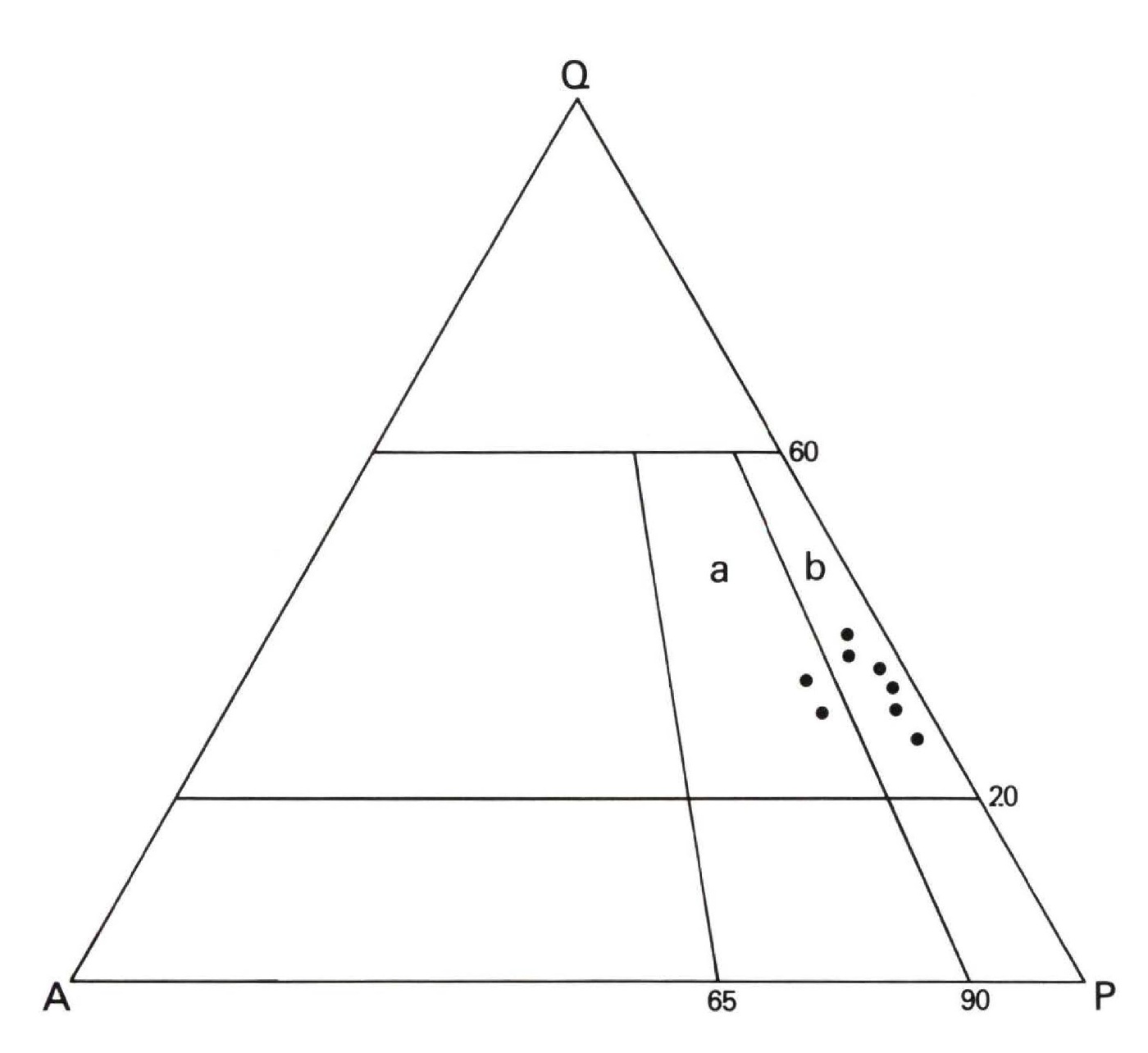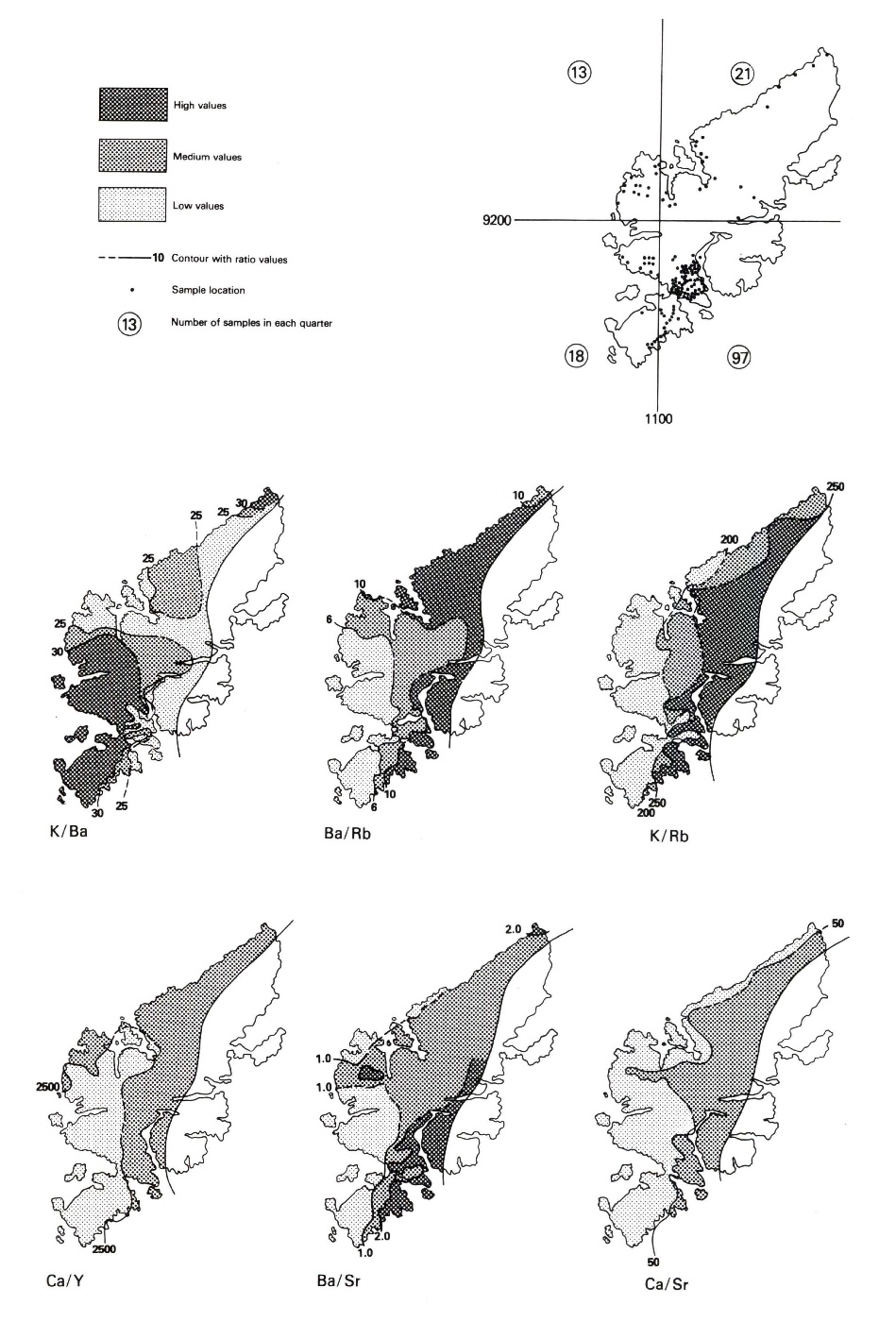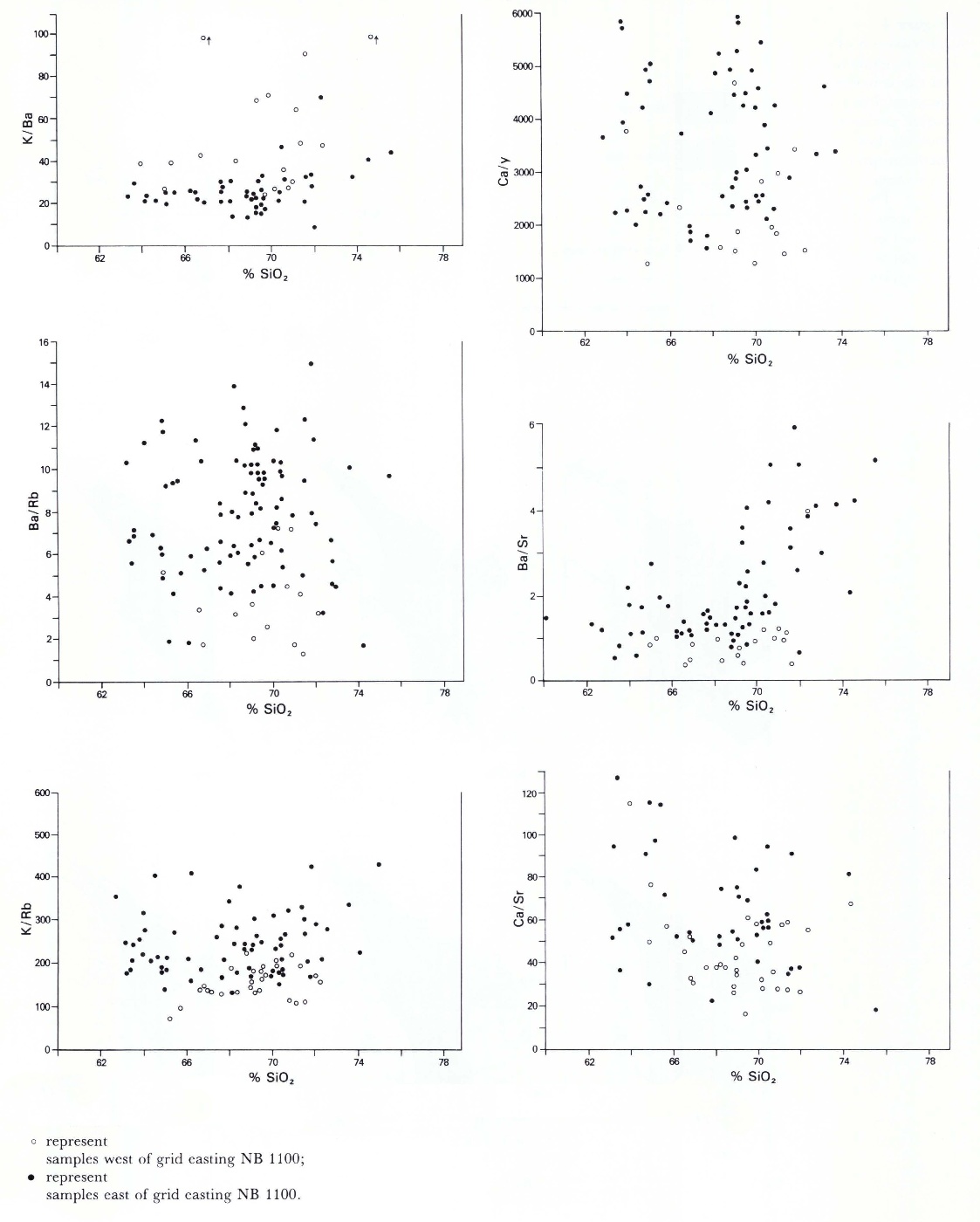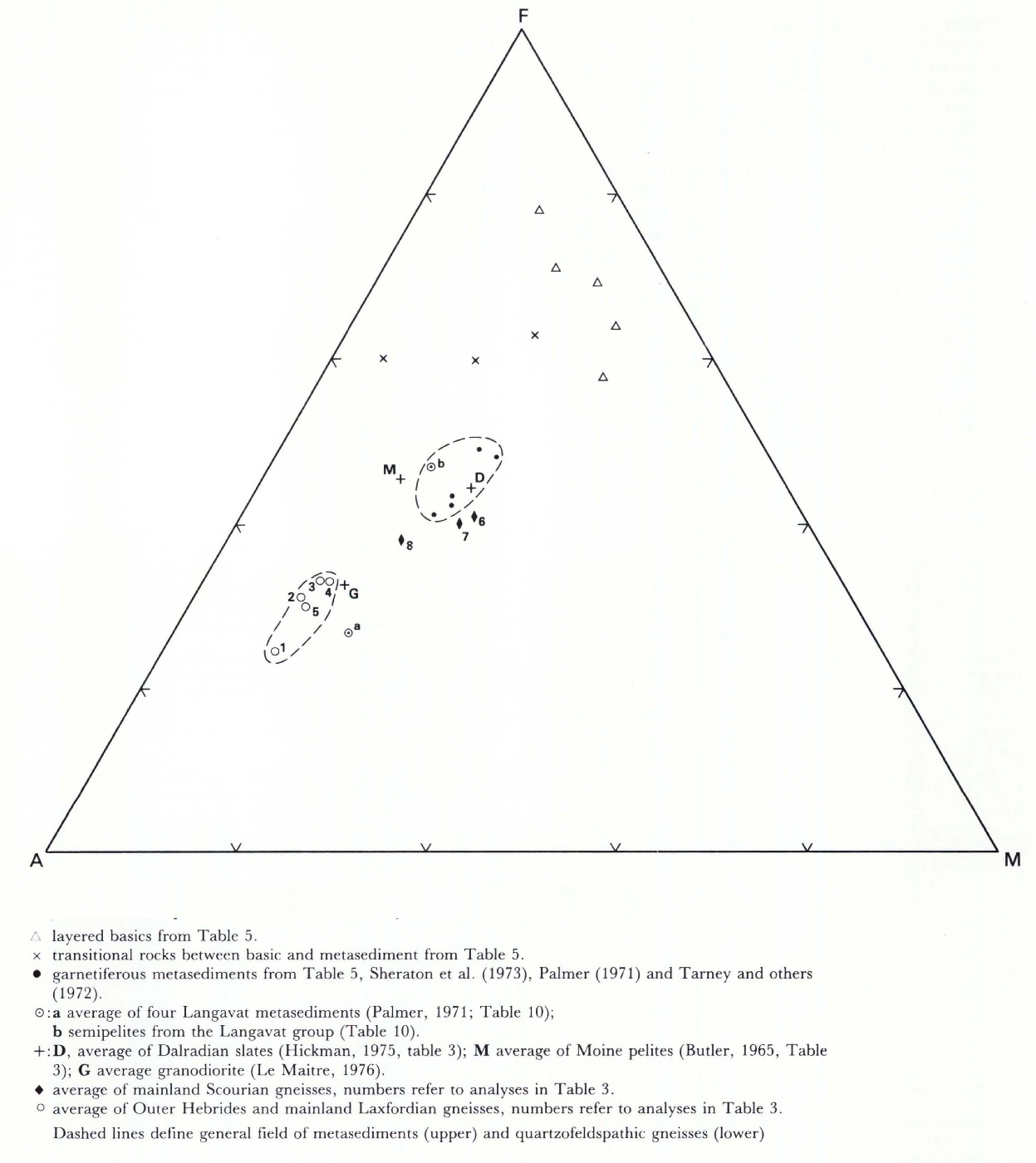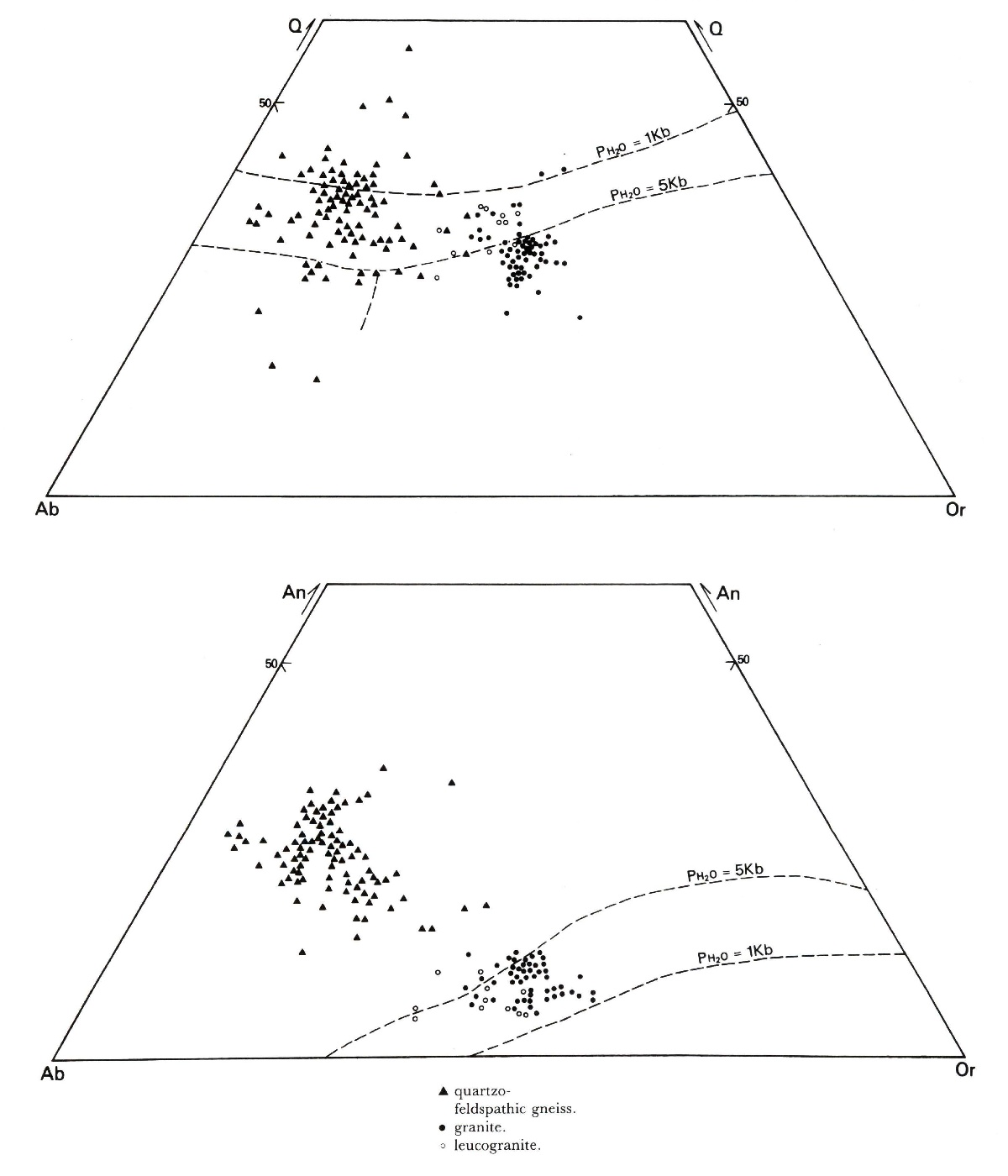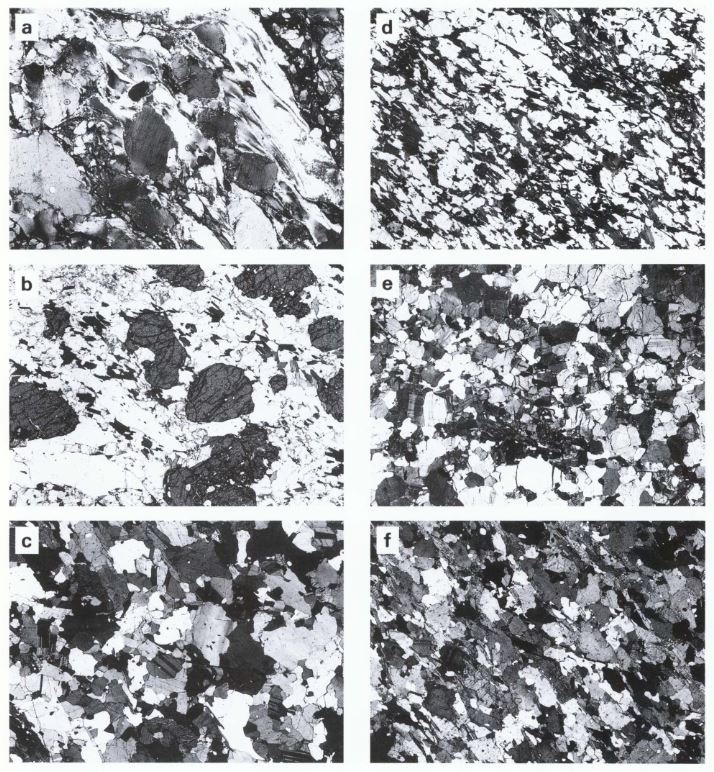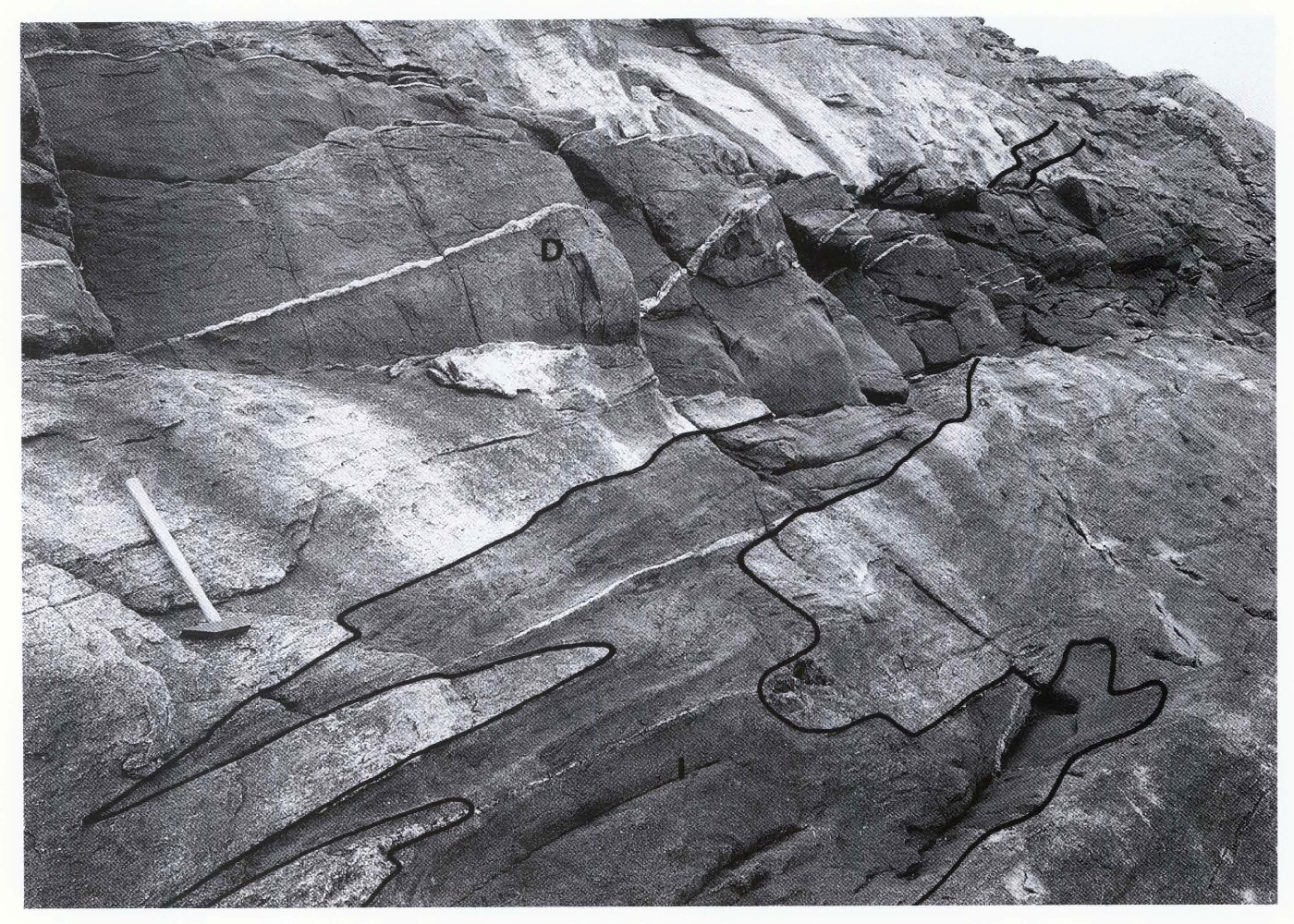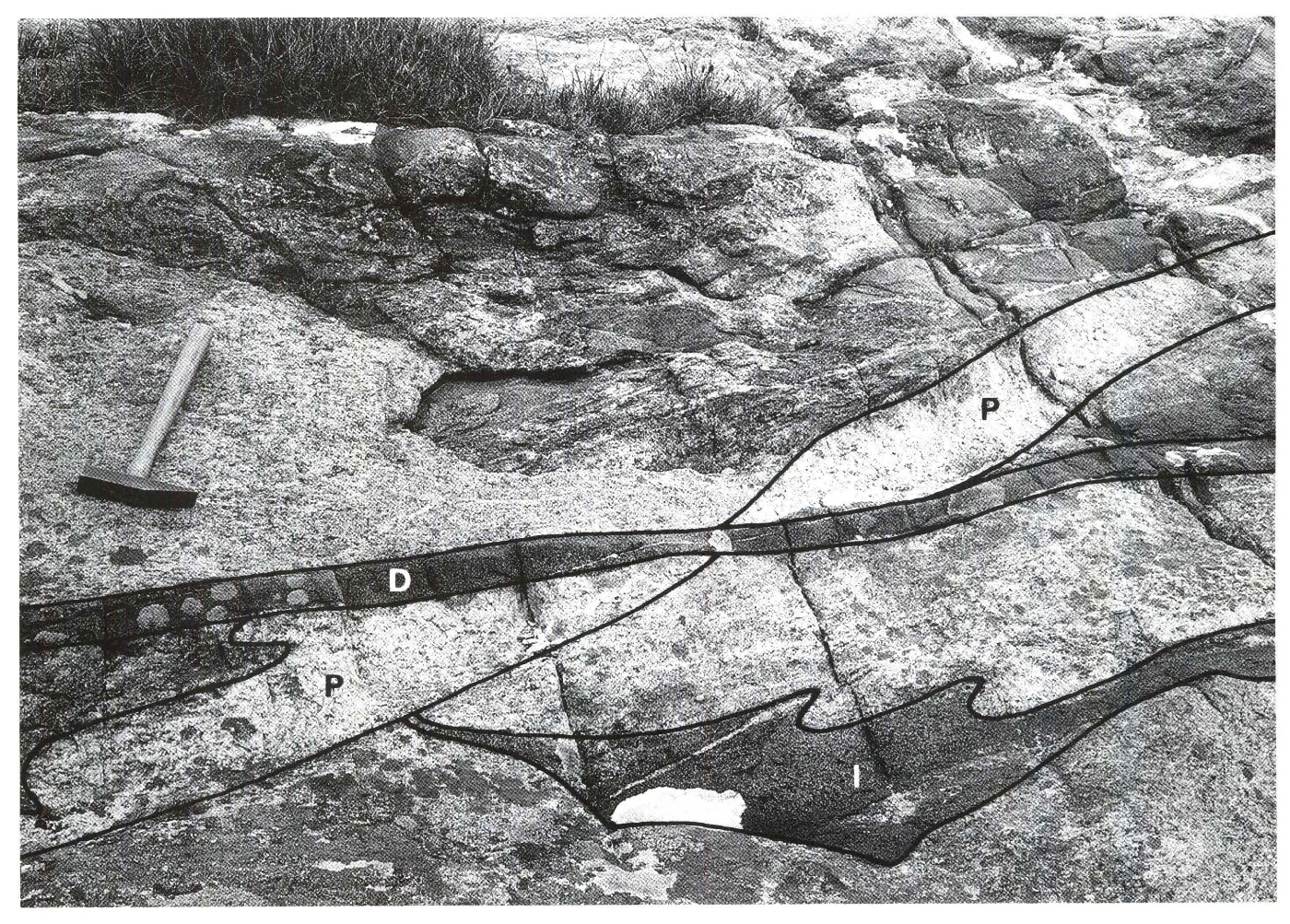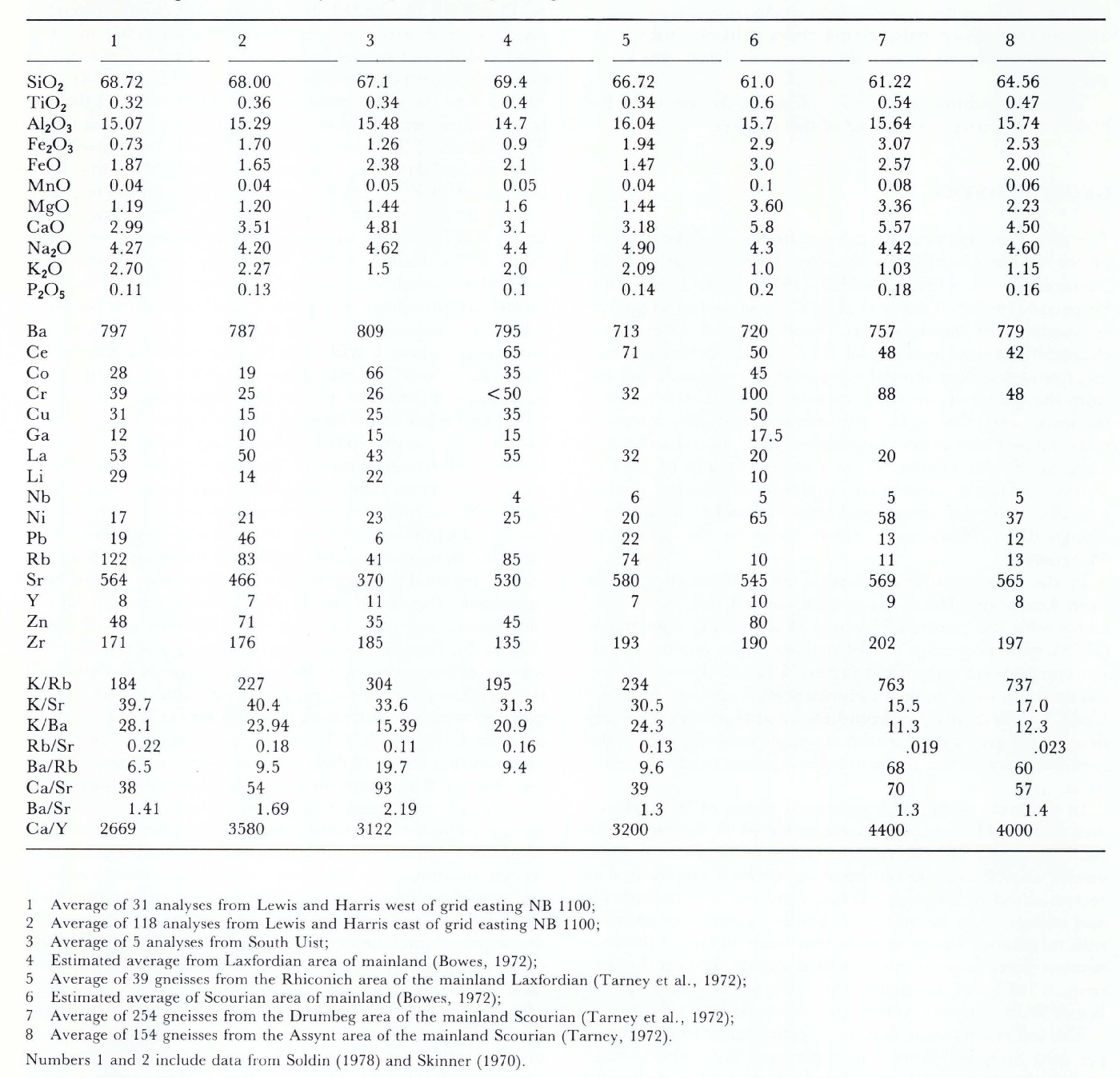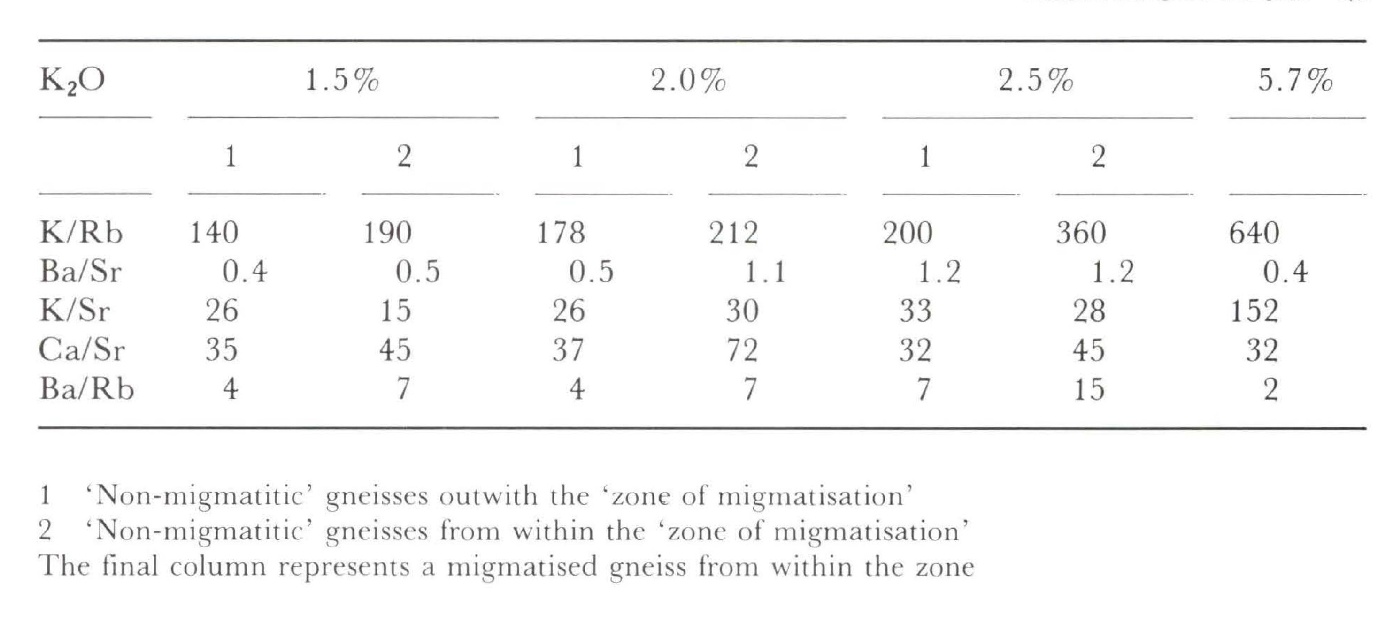Chapter 2 Lewisian Complex : introduction and quartzofeldspathic gneisses
Introduction
The term Lewisian Gneiss was suggested first by Murchison (1862) for the 'fundamental gneisses' of Scotland. It was not until the turn of the century, however, that the name came into general usage, when it was adopted by the Geological Survey as a composite term to cover all rocks of preTorridonian age. Murchison chose the name because of the preponderance of gneiss in the Isle of Lewis: indeed, with the exception of the Stornoway Beds and the Phanerozoic dyke swarms, the whole of the Long Island is composed of Lewisian rocks.
Within the Lewisian Gneiss complex of the Outer Hebrides several lithological groupings can be recognised, although in many areas deformation and metamorphism have blurred the distinctions between some of these groups and made them look similar. These groups form the basis of subdivision of the chapters on the Lewisian as follows:
- Quartzofeldspathic gneisses
- Metasedimentary and metavolcanic gneisses
- Older Basics and Ultrabasics
- Late-Scourian intrusions
- South Harris Igneous Complex
Corodale Gneiss - Ultrabasic complexes
- Younger Basics
- Late-Laxfordian granites and pegmatites
- Late-Laxfordian minor intrusions
Although the South Harris Complex contains elements of other groups (e.g. Late-Laxfordian granites and pegmatites) it has historically been treated as an entity both in research work and literature. We have therefore largely treated it as such in this memoir.
Lithology
Quartzofeldspathic gneiss is by far the most common rock type in the Outer Hebrides, forming the 'general country rock' of the area. The term is used to cover all the rocks not easily ascribed to any other lithological group and as such contains the highly metamorphosed and deformed derivatives of the other groups. To cover this rather amorphous grouping Dearnley (1962a) introduced the term 'grey gneiss'.
Although the gneiss is surprisingly uniform on a regional scale it is locally strongly heterogeneous. It consists of a grey medium- to coarse-grained rock which generally shows a rough banding defined by mafic concentrates. The composition varies from biotite gneiss to biotite-hornblende gneiss, with a variable but usually low amount of potash feldspar.
The gneisses may also exhibit lit-par-lit pegmatitic banding which is intense locally. In addition the gneisses generally contain a variety of basic and ultrabasic bands, lenses and clots, all of which may show some degree of assimilation and recrystallisation. Because of their long and involved history the gneisses show a wide variety of textures ranging from highly migmatised and homogenised rocks to fine-grained highly sheared banded gneisses. Further details of the banding and of the mesoscopic fabric are given in Chapter 3.
Lewis and Harris
Lewis and Harris consist of a mixture of biotite gneiss and biotite-hornblende gneiss. No attempt has been made during the present survey to delineate gneiss types. Jehu and Craig (1934) state that hornblende-biotite gneiss is prevalent in Lewis, and Stevens (1913) suggests that hornblende gneiss is dominant to the west of Stornoway. Beer (1952) reports hornblende gneiss as the prevalent rock type in northern Lewis, and suggests that hornblende-free biotite gneiss is relatively uncommon and restricted to localised outcrops where it characteristically weathers into small compact knolls. Pyroxene is rare in the gneisses.
Myers (1970a) and Soldin (1978) have distinguished and mapped out various gneiss types in Harris. Myers has three main types: biotite-banded gneiss, amphibolite-banded gneiss, and pegmatite-banded gneiss. Biotite-banded gneiss predominates in the west and south (Myers, 1970a, fig. 1). Soldin (1978, fig. 3.2) shows hornblende-biotite gneiss in a broad belt running westwards from Seaforth Island in the area south of Toddun
Migmatitic banding marked by lit-par-lit pegmatites, generally 2–5 cm thick, is developed throughout the region, although considerable local variation in intensity occurs. As shown below it records both Scourian and Laxfordian events. In Lewis the degree of migmatisation is relatively low over most of the region, increasing dramatically in the Uig Hills area. This is well seen on the roadside traverse westwards from Grimersta. At Loch Sgaire
In Harris migmatitic gneisses are particularly abundant in the south and west. They are equivalent to the pegmatite-banded gneisses of Myers (1970a) and the zone of granite gneiss of Soldin (1978). They are well seen south of Tarbert in various road cuttings, for example along the 'Golden Road' past Drineshader
Scourian migmatisation
This phase of migmatisation postdates the Older Basics; in many places the migmatisation invades and partially digests them to form basic agmatites. Agmatites of this type which have been relatively unaffected by later deformation can be seen at various localities (see Myers, 1971, fig. 1) in Harris. Elsewhere blebs and lenses of Older Basics can commonly be seen in the migmatitic gneiss, for example on the south facing cliffs of Aird Fenish. At the roadside quarry east of Loch Sgaire
The Scourian age of much of the migmatisation is easily demonstrated with numerous examples of Younger Basic dykes cutting migmatitic banding, for example at Enaclete
Laxfordian migmatisation and pegmatites
The pre-dyke or Scourian migmatisation is quite separate from the extensive phases of recrystallisation or remobilisation of the migmatitic gneisses which occurred during the Laxfordian. At several localities near Flodabay
This second phase of migmatisation is generally very variable and many areas are largely unaffected (see below). Since it results in part from a remobilisation of the earlier migmatitic lits it reaches its greatest development in areas of strong Scourian migmatisation. In its weakest form the Laxfordian migmatisation is evidenced by intense recrystallisation leading to pegmatite production in the sheared out or attenuated limbs of folds (e.g. the roadside north of Kinlochroag
Where the gneisses have not been subjected to extensive Late-Laxfordian recrystallisation, their appearance in the field is very much controlled by their degree of deformation. Where the rock is highly strained, the migmatitic Scourian banding is characteristically streaked out to present a fine- to medium-grained, finely banded rock. The pegmatitic lits are in many places disrupted to form a series of augen. Rocks of this type are seen on the road south from Stornoway
In addition to these essentially ductile deformational effects, the gneisses of Lewis characteristically show some degree of late-stage cataclasis. Although these textures are generally greatest towards the thrust zone, nearly all the gneisses show, at least in thin section, evidence of late deformation. Peach and Home (1930) remarked on this widespread cataclasis and highlighted it as one of the differences between the gneisses of the Outer Hebrides and those of the North-west Highlands. Below the Outer Hebrides Thrust, late-stage deformation is locally intense within a belt running north-westwards across Lewis bounded on the south-west by Loch Roag and Loch Seaforth, and on the east by a line through Callanish and the head of Loch Erisort. Within this belt the gneisses commonly exhibit a platy texture with concordant bands of ultramylonite. Within the thrust zone the rocks typically show evidence of low-grade alteration. In South Harris this zone of alteration appears below the thrust. Here, the rocks have a characteristic rather soapy look, and are rich in epidote. These rocks and their probable relationship to the thrust are discussed in Chapter 15: Mylonites; Folding.
Uist and Benbecula
In this region, which is taken to include the islands in the Sound of Harris, there is a recognisably higher proportion of metasediments and characteristically banded Older Basics than in Lewis and Harris. In addition much of central North Uist and the islands in the Sound of Harris consist of fine-grained gneisses with metasedimentary affinities: these rocks are discussed separately below. Otherwise the gneisses are essentially the same as those in the northern isles, being a mixture of banded biotite gneisses and biotite-hornblende gneisses with a variable number of pink pegmatitic lits. There is little information on the relative distribution of the gneiss types: Jehu and Craig (1925) suggest that biotite gneiss is the most common rock-type west of the thrust in South Uist. On the north-west coast of North Uist, Jehu and Craig (1926) describe areas of very pink acid gneiss, which they suggest are probably later than the biotite-hornblende gneiss. Graham (1970) also distinguishes a 'rough' and a 'smooth' gneiss on the north-west coast, the smooth gneiss being described as 'unhanded, homogeneous and finer grained than "rough gneiss'. The 'smooth gneiss' would, therefore, appear to be the same as Jehu and Craig's acid gneiss. In this memoir this 'gneiss' is regarded as a Late-Scourian 'granite' and is discussed in the appropriate section below (p.45).
Coward et al. (1969) and Coward (1973b, fig.1) report the occurrence of pyroxene-bearing gneisses in the Loch Skiport area, which they attribute to an early granulite-facies metamorphism. Another small patch of pyroxene-bearing gneiss occurs in association with a large cross-cutting dyke on Beinn Bheag Dheas
Dearnley (1962a) originally divided this area into northern and southern parts, the southern part being characterised by, among other things, a preponderance of migmatites analagous to those of the Uig Hills and West Harris. Dearnley (1962a, pl. ix) also showed the north-western part of North Uist as being highly migmatised. Dearnley and Dunning (1968) cite several localities, mainly on the west coast of South Uist, where the gneisses show evidence of strong Laxfordian migmatisation.
Scourian migmatisation
A distinction must be drawn, however, between Scourian and Laxfordian migmatisation. Scourian migmatisation is widespread throughout the region although, as in Lewis and Harris, of variable intensity. Migmatised gneisses evidenced by pink pegmatite lits are cut by Younger Basic dykes, for example, at Ludag
Laxfordian migmatisation
Post-dyke migmatisation and remobilisation of the gneisses was less widespread than in the Scourian phase, and as in Lewis and Harris it is most intense in areas of pre-dyke migmatisation. It is manifested by the general coarsening of the gneiss and a destruction of the gneissose banding. Coarsely crystallised bands have formed, some with disseminated hornblende, apparently as a result of a local recrystallisation of the gneiss. Elsewhere locally generated pegmatite stringers and veinlets intrude the surrounding gneiss. It is, however, around the Younger Basic dykes that the greatest degrees of remobilisation are observed, with numerous examples of the dykes being assimilated or recrystallised. For example, at Trollaskeir
Examples of basic dykes being assimilated by remobilised gneiss are described by Kursten (1957), from the south face of Arnaval. It is important to emphasise the rapid variation in intensity of migmatisation. This is dramatically shown in the quarry at Howmore
The only area where this post-dyke remobilisation of the gneiss reaches an intensity comparable with that seen in Harris is in the area below the thrust between Hecla
Although there are regional zones of vertically foliated, uniformly striking gneiss the rock does not show the same intensity of deformation seen in similar zones in Lewis: the Scourian banding and pegmatitic lits are less broken and boudinaged. Indeed, except where it has been locally homogenised or remobilised during the Laxfordian the main banding seen in the gneiss can be considered as an essentially Scourian fabric.
Within the thrust zone the rocks are extremely deformed and affected by low-grade alteration. In northern South Uist this late alteration extends below the thrust and affects a large area of relatively undeformed rocks. These effects are discussed in Chapter 15: Mylonites, and Late-stage alteration.
Barra and the southern isles
Barra and the neighbouring isles exhibit a variety of gneiss types. On Barra thrust phenomena are confined to a relatively narrow zone, which more or less bisects the island. The rocks above and below this thrust zone are largely unaffected by thrust movements. Above the thrust zone pyroxene-bearing gneisses with a characteristically brown colouring are common on Flodday, Fuiay, Bruernish Headland, and in the area east of a line through Earsary and the head of Loch Obe. Below the thrust, pyroxene gneisses are common on Hellisay, Gighay, Greanamul and Garbh Lingay (see also Francis, 1973). Elsewhere the rock is a mixture of banded biotite gneiss and hornblende-biotite gneiss with a variable number of ultrabasic and basic bands, lenses and clots.
Scourian migmatisation
As in the northern islands the gneisses are commonly migmatitic, with abundant pegmatite lits. Gneiss of this type is excellently exposed at several localities, for example at Borve
There are many examples of Older Basics being agmatised by the Scourian migmatisation, for example at Halaman Bay
Laxfordian migmatisation
Remobilisation of the migmatitic lits during the Laxfordian is common, reaching its strongest development on Barra in a zone running south-eastwards from Beinn nan Carnan
Post-dyke migmatisation and remobilisation is also common on the other southern isles. On Pabbay the effects increase westwards with the amphibolites becoming strongly agmatised and swamped in pegmatite. Similar effects are also seen on the west side of Sandray, and on Mingulay some good examples of basic agmatites are seen on the shore at
Note on the distant isles
The distant islands of North Rona, Sula Sgeir and the Flannans have not been surveyed during the present investigation. The following paragraph is included only as a reference.
On North Rona Nesbitt (1961) records two belts of acid gneiss flanking a central amphibolite body (see Chapter 4: Banded Basics of the northern isles). The general assemblage of the gneiss is given as qz-olig-kf-bi, with zircon as an accessory. Analysis of the gneiss by Bowes (in Nesbitt, 1961) is broadly similar to that of the gneiss on the Long Island (
Petrography
It is clear from the above account that the components of the quartzofeldspathic gneisses range in composition from basic to acid. Most of the gneisses, however, lie near the centre of this range. Modal analyses of the main gneiss types (the samples were chosen to cover the range 65 to 71 per cent SiO2 in the analysed samples) are given in
In thin section the gneisses show a range of textures from granoblastic medium- to coarse-grained to schistose and highly recrystallised varieties (
Typically the gneisses contain qz-pl-kf-bi-(hbl)-(px) assemblages. The accessories may include apatite, zircon, epidote, allanite, sphene and iron ores with secondary white micas and chlorite. There is a complete gradation from hornblende-biotite gneiss to biotite gneiss, the biotite gneiss being the more leucocratic. Apart from chemical composition the mineral phases in the gneisses are controlled by their metamorphic and deformational state. The gneisses range from opx-cpx bearing assemblages to hbl-bi bearing assemblages, and are described as such below. It should be stressed that there is no implication that all the gneisses with lower metamorphic grade assemblages are retrograde products of original high-grade assemblages. Indeed, as is discussed later (p.23), it is believed that very few of the gneisses ever crystallised in the two-pyroxene facies.
The highest grade rocks contain pyroxene. They are particularly abundant in north-eastern Barra and the Loch Skipport area of South Uist but occur only rarely elsewhere.
These rocks generally exhibit granoblastic textures with individual crystals of about 1.0 mm (
In lower-grade assemblages the aggregates of pyroxene are replaced by large (c.2.5 mm) crystals of hornblende. The small equant grains of hornblende may also be present. Potash feldspar is more common, generally as orthoclase, more rarely as microcline. Myrmekite is also relatively common. The plagioclase shows little change although a few crystals display marginal zoning to a more sodic variety. It is possible that the average anorthite content is lower than in the higher-grade assemblages as andesine appears to be less common. With the increase of modal hornblende at the expense of pyroxene the iron oxides virtually disappear, suggesting their incorporation into the amphibole. Those that remain invert in part to sphene, which appears as an accessory with apatite and epidote. At the same time quartz increases both in size and modal amount. The lowest-grade assemblages examined in this sequence contain pale green-brown biotite and large (c.6 mm) crystals of blue-green hornblende enclosing small subidiomorphic grains of quartz and plagioclase. The felspar and quartz crystals are generally smaller (c.2 mm) than the mafic minerals. They are similar to those of higher grade. The crystals of quartz and feldspar do not show any good crystal faces and the order of crystallisation is difficult to determine. Only potash feldspar, which tends to be interstitial, may be regarded as a late phase. In an extensive examination of hornblende-biotite and biotite gneisses in North Harris (Soldin, 1978) reports several mineral analyses that show the amphiboles to be in the range from ferro-edenitic hornblende to magnesian hastingsitic hornblende (sensu Leake, 1978). The plagioclase averages Or: Ab: An = 1: 72: 27. Soldin (1978) reports the presence of antiperthites and perthites; microcline he records as rare. Peach and Horne (1930, p.59) remarked on the relative abundance of allanite in the gneisses of Lewis in contrast to those of the north-east Scottish mainland. Beer (1952), however, records that the hornblende-biotite gneisses generally contain no allanite, that mineral being confined to the biotite gneisses, and even there it is much less common than in the intrusive Laxfordian granites (q.v.). Some of the biotite gneisses also contain a relatively large proportion of sphene; it is interesting to note that hornblende-biotite gneisses with similar amounts of TiO2 do not carry sphene, supporting the suggestion made above that at this grade the TiO2 is tied up in amphibole.
The degree of late-stage 'cataclasis' and low-grade recrystallisation has an important influence on the texture and paragenesis of the minerals (
The relationship of the various phases to the metamorphic history is discussed at the end of this chapter.
| Thin Section No. | Grid reference | Quartz | Plagioclase | K-feldspar | Biotite | Hornblende | Epidote | Others |
| (S61122) |
35.4 | 56.2 | 3.4 | 4.1 | – | 0.7 | 0.2 | |
| (S61135) |
32.7 | 48.2 | 2.2 | 11.8 | – | 4.9 | 0.2 | |
| (S58832) |
30.0 | 49.3 | 8.8 | 11.0 | – | 0.7 | 0.2 | |
| (S58768) |
29.6 | 59.0 | 1.3 | 8.6 | – | 1.4 | 0.1 | |
| (S61144) |
27.0 | 49.0 | 0.7 | 13.1 | 6.0 | 3.8 | 0.4 | |
| (S61139) |
25.2 | 55.8 | 2.6 | 10.7 | 4.9 | 0.3 | 0.5 | |
| (S58835) |
22.9 | 44.9 | 7.5 | 8.9 | 12.0 | 3.6 | 0.2 | |
| (S58825) |
22.4 | 57.7 | 2.2 | 8.0 | 0.6 | 8.5 | 0.6 | |
| Mean | 28.1 | 52.6 | 3.6 | 9.6 | 3.0 | 3.0 | 0.3 | |
| RL* | 27.2 |
57.8 |
12.7 |
2.3 |
||||
- RL* Mean of 14 analyses of the leucogneiss component of grey gneiss (from Lisle, 1974).
Geochemistry
The only previous work on the geochemistry of the gneisses of the Outer Hebrides is that by Tarney et al. (1972), Sheraton et al. (1973), Soldin (1976), and Bowes and Hopgood (1969a). Tarney et al. (1972), as part of a regional comparison of north-western Scotland and Greenland, characterised the chemistry of the Outer Hebrides gneisses and found that they showed a regional increase in K and Rb from the gneiss of the northern and eastern Lewis towards the south-west, that is, into the area dominated by intensely recrystallised Scourian migmatite and Late-Laxfordian granites. Soldin (1978), in an extensive study of part of northern Harris, produced analyses of biotite gneiss, hornblende-biotite gneiss and granitic rocks. Bowes and Hopgood's (1969a) work refers only to the island of Mingulay.
In the present survey a further 34 analyses of gneisses from Lewis and Harris have been carried out, and these, along with the results of Tarney et al. (1972) and Soldin (1978), give a coverage of 149 analyses in the northern isles. For comparative purposes a further 5 full analyses and partial analyses were made on representative gneisses from the Uists. The BGS analyses from Lewis and Harris were largely designed to give a representative sample from the west of the area. No attempt was made to collect the specimens on a grid basis.
In the areas of highly migmatised gneiss of West Harris and the Uig Hills, samples were collected to represent both the highly pegmatised 'sugary' gneiss and the remobilised gneiss, as well as rocks representing the least migmatised or recrystallised varieties, that is rocks without pink potassic lits and stringers. In sampling the banded gneisses or gneisses with migmatitic lits an attempt was made to collect the constituent parts in proportion to their appearance on the outcrop. A full list of the analyses is on file at the Edinburgh office of BGS. Average values are presented in
The full results show that the gneisses range from 62 to 75 per cent SiO2 and from 1 to 6 per cent K2O, the average analysis being broadly equivalent in composition, except for higher soda values, to a granodiorite/adamellite with a range from granite to tonalite (Le Maitre, 1976). The gneisses also have relatively high values of La and low Nb and Y compared with Taylor's (1966) averages for granitic and granodioritic rocks. Compared with Taylor's average crust the gneisses are relatively rich in Ba and La and poor in Y and Nb (values from Tarney et al., 1972). Ternary plots (normative Q-ab-or, an-ab-or) are shown on
In order to test whether there are regional variations across Lewis and Harris (as suggested by Tarney et al., 1972) the ratios K/Ba, Ba/Rb, K/Rb, Ca/Y, Ba/Sr and Ca/Sr were selected as probably significant parameters and plotted. The results are presented in
| 1 | 2 | 3 | 4 | 5 | 6 | 7 | 8 | |
| SiO2 | 68.72 | 68.00 | 67.1 | 69.4 | 66.72 | 61.0 | 61.22 | 64.56 |
| TiO2 | 0.32 | 0.36 | 0.34 | 0.4 | 0.34 | 0.6 | 0.54 | 0.47 |
| Al2O3 | 15.07 | 15.29 | 15.48 | 14.7 | 16.04 | 15.7 | 15.64 | 15.74 |
| Fe2O3 | 0.73 | 1.70 | 1.26 | 0.9 | 1.94 | 2.9 | 3.07 | 2.53 |
| FeO | 1.87 | 1.65 | 2.38 | 2.1 | 1.47 | 3.0 | 2.57 | 2.00 |
| MnO | 0.04 | 0.04 | 0.05 | 0.05 | 0.04 | 0.1 | 0.08 | 0.06 |
| MgO | 1.19 | 1.20 | 1.44 | 1.6 | 1.44 | 3.60 | 3.36 | 2.23 |
| CaO | 2.99 | 3.51 | 4.81 | 3.1 | 3.18 | 5.8 | 5.57 | 4.50 |
| Na2O | 4.27 | 4.20 | 4.62 | 4.4 | 4.90 | 4.3 | 4.42 | 4.60 |
| K2O | 2.70 | 2.27 | 1.5 | 2.0 | 2.09 | 1.0 | 1.03 | 1.15 |
| P2O5 | 0.11 | 0.13 | 0.1 | 0.14 | 0.2 | 0.18 | 0.16 | |
| Ba | 797 | 787 | 809 | 795 | 713 | 720 | 757 | 779 |
| Ce | 65 | 71 | 50 | 48 | 42 | |||
| Co | 28 | 19 | 66 | 35 | 45 | |||
| Cr | 39 | 25 | 26 | <50 | 32 | 100 | 88 | 48 |
| Cu | 31 | 15 | 25 | 35 | 50 | |||
| Ga | 12 | 10 | 15 | 15 | 17.5 | |||
| La | 53 | 50 | 43 | 55 | 32 | 20 | 20 | |
| Li | 29 | 14 | 22 | 10 | ||||
| Nb | 4 | 6 | 5 | 5 | 5 | |||
| Ni | 17 | 21 | 23 | 25 | 20 | 65 | 58 | 37 |
| Pb | 19 | 46 | 6 | 22 | 13 | 12 | ||
| Rb | 122 | 83 | 41 | 85 | 74 | 10 | 11 | 13 |
| Sr | 564 | 466 | 370 | 530 | 580 | 545 | 569 | 565 |
| Y | 8 | 7 | 11 | 7 | 10 | 9 | 8 | |
| Zn | 48 | 71 | 35 | 45 | 80 | |||
| Zr | 171 | 176 | 185 | 135 | 193 | 190 | 202 | 197 |
| K/Rb | 184 | 227 | 304 | 195 | 234 | 763 | 737 | |
| K/Sr | 39.7 | 40.4 | 33.6 | 31.3 | 30.5 | 15.5 | 17.0 | |
| K/Ba | 28.1 | 23.94 | 15.39 | 20.9 | 24.3 | 11.3 | 12.3 | |
| Rb/Sr | 0.22 | 0.18 | 0.11 | 0.16 | 0.13 | .019 | .023 | |
| Ba/Rb | 6.5 | 9.5 | 19.7 | 9.4 | 9.6 | 68 | 60 | |
| Ca/Sr | 38 | 54 | 93 | 39 | 70 | 57 | ||
| Ba/Sr | 1.41 | 1.69 | 2.19 | 1.3 | 1.3 | 1.4 | ||
| Ca/Y | 2669 | 3580 | 3122 | 3200 | 4400 | 4000 |
- 1 Average of 31 analyses from Lewis and Harris west of grid easting NB 1100;
- 2 Average of 118 analyses from Lewis and Harris east of grid casting NB 1100;
- 3 Average of 5 analyses from South Uist;
- 4 Estimated average from Laxfordian area of mainland (Bowes, 1972);
- 5 Average of 39 gneisses from the Rhiconich area of the mainland Laxfordian (Tarney et al., 1972);
- 6 Estimated average of Scourian area of mainland (Bowes, 1972);
- 7 Average of 254 gneisses from the Drumbeg area of the mainland Scourian (Tarney et al., 1972);
- 8 Average of 154 gneisses from the Assynt area of the mainland Scourian (Tarney, 1972).
- Numbers 1 and 2 include data from Soldin (1978) and Skinner (1970).
In the Uists the results (column 3,
These results are in accord with the ideas of McQuillin and and Watson (1973) who suggested that the Hebrides possessed a NE-SW lithological grain evidenced by a westward fall in the regional gravity anomaly map. The reasons for this regional variation are matters of considerable speculation. Two possibilities might be considered. Firstly, the general trend in the various elemental ratios in the gneisses from the Uists, through eastern Lewis and Harris to western Lewis and Harris is similar to changes recognised in Coll and Tiree by Drury (1974) and interpreted as due to the amphibolitisation of granulite-facies rocks. In this context it may be significant that the main areas of pyroxene-bearing gneiss in the Outer Hebrides are in eastern South Uist and east Barra (see below). Secondly, Tarney et al. (1972) suggested that mantle degassing during the Archaean might lead to a general upward diffusion of the lighter elements through the crust. Developing these arguments it is possible that the western half of Lewis and Harris may represent a higher crustal level than the east coast, or at least an area where the removal of lighter elements is less advanced. It is interesting to note in this context that Moorbath et al. (1975) state that the gneisses of South Uist, Benbecula and Barra have suffered extreme depletion in uranium relative to those of North Uist although they ascribe the depletion to Scourian metamorphism. The possibility that the differences may simply reflect a change in the original lithologies (see pp.12–14) seems less likely given the gradational nature of the variations.
| K2O | 1.5% | 1.5% | 2.0% | 2.0% | 2.5% | 2.5% | 5.7% |
| 1 | 2 | 1 | 2 | 1 | 2 | ||
| K/Rb | 140 | 190 | 178 | 212 | 200 | 360 | 640 |
| Ba/Sr | 0.4 | 0.5 | 0.5 | 1.1 | 1.2 | 1.2 | 0.4 |
| K/Sr | 26 | 15 | 26 | 30 | 33 | 28 | 152 |
| Ca/Sr | 35 | 45 | 37 | 72 | 32 | 45 | 32 |
| Ba/Rb | 4 | 7 | 4 | 7 | 7 | 15 | 2 |
- 1. 'Non-migmatitic' gneisses outwith the 'zone of migmatisation'
- 2 'Non-migmatitic' gneisses from within the 'zone of migmatisation'
- The final column represents a migmatised gneiss from within the zone
This discussion is a preliminary statement of the problem. A possible solution must await a detailed investigation beyond the scope of the present survey. Chemical studies, in particular, will have to be conducted with great care in order to distinguish possible metasomatic effects from variation in original lithology, and will also need to take account of the possible preferential susceptibility of some lithologies to recrystallisation.
Metamorphism
As described above, the quartzofeldspathic gneiss shows a variety of mineral assemblages ranging from two-pyroxene granulite facies to the lower amphibolite/greenschist facies. At the present time by far the greater part of the gneisses are the amphibolite facies, the higher-grade rocks being restricted to a few localities mainly in Barra and South Uist. The question arises as to the age and extent of the granulitefacies metamorphism.
Dearnley (1962a) regarded Laxfordian crystallisation as falling into two distinct phases, an early granulite-facies metamorphism and a later retrogressive-amphibolite facies event. However this interpretation now seems unlikely (Coward et al., 1969; Moorbath et al., 1975) and the majority of workers probably regard Laxfordian recrystallisation to have taken place largely in the amphibolite facies (e.g. Myers, 1970a; Taft, 1978), with only very local recrystallisation in the granulite facies (Coward, 1973b; Myers, 1971). Although in some areas amphibolite facies recrystallisation appears to have continued beyond the deformational episodes, in others late deformational events are associated with upper greenschist conditions.
The main development of granulite-facies rocks is believed to be of Scourian age; the extent, however, is very uncertain. In Barra, Francis (1973) suggested that the boundary between his eastern and western gneiss, which roughly coincides with the present boundary between granulite- and amphibolite-facies rocks, was the junction between an infrastructure and a suprastructure. It seems more likely, however, to be the edge of extensive Laxfordian reworking, possibly controlled by pre-existing differences in the metamorphic grade, suggesting that the Scourian granulite facies did not extend much beyond its present outcrop.
The chemistry of the amphibolite-facies gneisses closely corresponds to that in the Laxfordian areas of the mainland, that is, they are relatively rich in lithophiles and thorium ('Carney et al., 1972), which might indicate that the rocks had not been subjected to granulite-facies metamorphism (Heier, 1973). It is worth noting in this context that in their chemistry the Uist gneisses are in part intermediate between the gneisses of Harris and Lewis and those of the Scourian block of the mainland, perhaps indicating a progressive depletion of lighter elements and increase in metamorphic grade southwards towards Barra and South Uist. Moorbath et al. (1975), working on lead isotopes show that the gneisses of South Uist and Barra, unlike those of North Uist, suffered extreme depletion in uranium during the Scourian; this may be taken to indicate more extensive granulite-facies metamorphism in the south with subsequent retrogression.
It is, therefore, concluded that during the Scourian the gneisses locally reached granulite facies particularly in the south and east, although the exact original extent of these high-grade rocks is unknown. The Laxfordian was dominated by amphibolite-facies recrystallisation, the granulite-facies rock that remains presumably resisted amphibolitisation because of the lack of available water.

